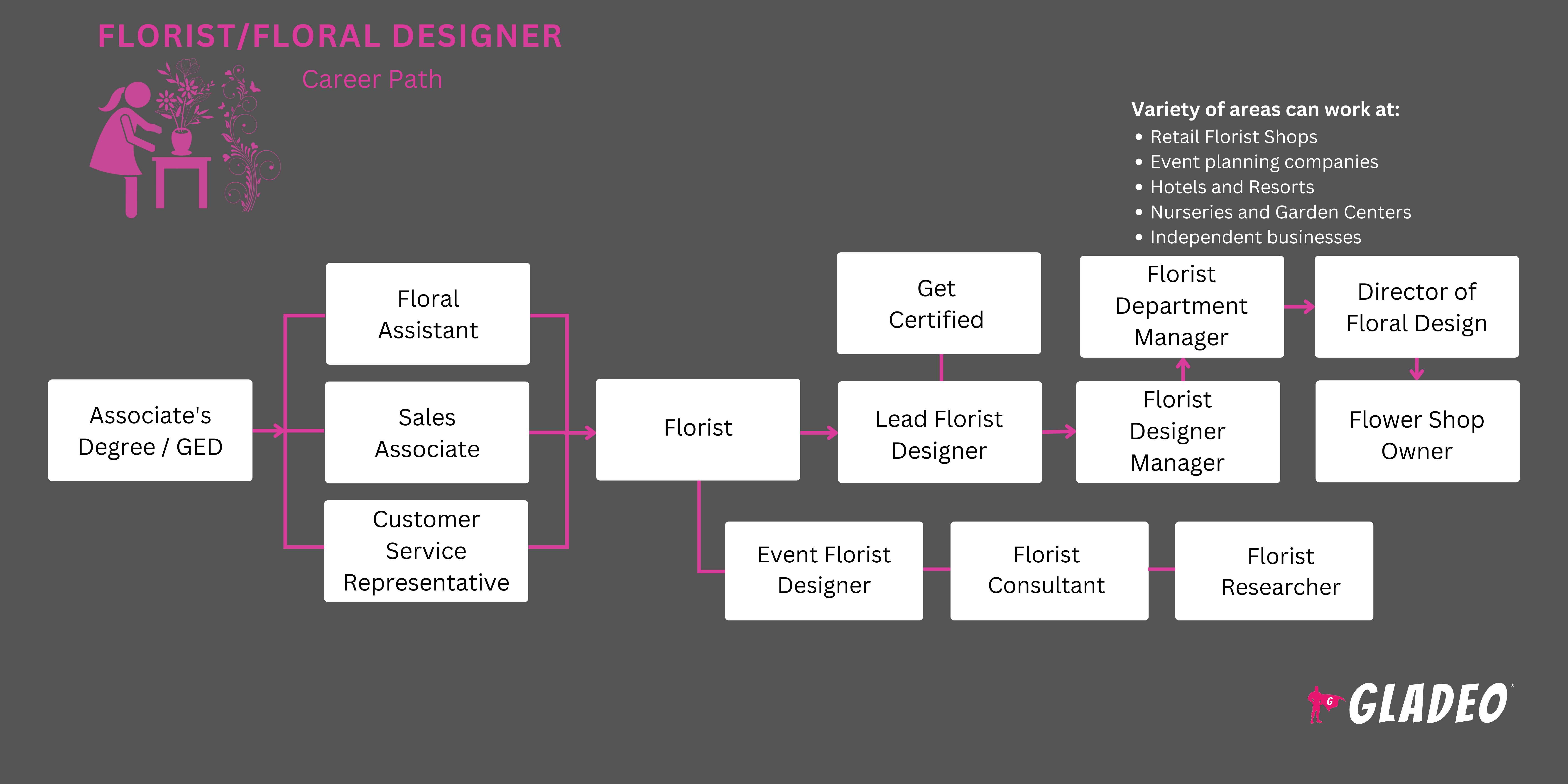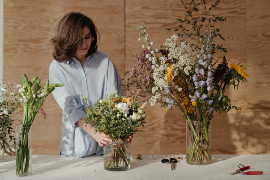Focos
Diseñador, artista floral, dependiente floral, especialista en el departamento floral, diseñador floral, florista, decorador de bodas.
¡Regalar flores en ocasiones especiales es una tradición que se remonta a la antigua cultura egipcia! Hoy en día, seguimos regalando flores para expresar diversos sentimientos, desde el amor hasta las condolencias. Los floristas (o diseñadores florales, si lo prefieres) son los orgullosos guardianes de esta antigua costumbre. Adquieren flores frescas de granjas y mayoristas locales y luego las seleccionan cuidadosamente y las combinan en coloridos arreglos decorativos o ramos envueltos.
Como expertos en este campo único y relativamente pequeño, los floristas suelen ayudar a los clientes a decidir qué flores son las más adecuadas para cada ocasión y presupuesto. Muchos floristas son autónomos, regentan pequeños negocios locales y ofrecen servicios de entrega a domicilio. Otros pueden trabajar en las secciones de flores de grandes tiendas minoristas o supermercados. Independientemente de dónde trabajen, los floristas son artistas creativos y empáticos que crean arreglos florales significativos diseñados para marcar la diferencia en la vida de quienes los reciben.
- Poder pasar tiempo trabajando tranquilamente con flores y plantas.
- Tener una vía de expresión creativa.
- Saber que tu trabajo ayudará a que alguien se sienta mejor.
- La posibilidad de llegar a ser propietario y gestionar tu propio pequeño negocio.
Horario de trabajo
- Los floristas pueden trabajar a tiempo completo o parcial. Los que tienen su propio negocio pueden hacer horas extras para asegurarse de que haya suficientes flores frescas y otros productos en stock, que la tienda esté ordenada y sea visualmente atractiva, que el personal esté bien atendido, que los vehículos de reparto estén en buenas condiciones, que el marketing funcione correctamente y que la contabilidad se lleve a cabo de forma adecuada. También es probable que se requieran horas extras durante las temporadas altas, como el Día de la Madre y San Valentín.
Funciones típicas
- Mantenga la floristería o el área de venta con un aspecto limpio y profesional, y los espacios de trabajo desinfectados y libres de desorden.
- Determinar las necesidades de inventario. Buscar y adquirir inventario de proveedores, mayoristas y productores locales.
- Crea arreglos florales ya preparados y ramos para llevar.
- Establecer precios y marcar artículos. Registrar ventas, incluyendo artículos adicionales como tarjetas, globos, peluches, cestas, jarrones, etc.
- Ayudar a los clientes por teléfono, en línea y en persona con sus requisitos de arreglos personalizados. Ofrecer sugerencias basadas en presupuestos, ocasiones y fechas de entrega deseadas.
- Seleccione flores, plantas, follaje y recipientes que combinen entre sí. Cree arreglos basados en patrones establecidos o diseñe conceptos únicos.
- Recorte las flores y otros materiales según sea necesario para adaptarlos al arreglo. Utilice alambre, alfileres, cinta adhesiva y otros materiales de sujeción.
- Entregar o establecer la entrega de los arreglos a los destinatarios previstos.
- Mantenga las flores refrigeradas según sea necesario. Riegue las flores y las plantas.
- Crear escaparates y expositores para la tienda, incluyendo expositores con temática navideña.
Responsabilidades adicionales
- Descargar las entregas de inventario entrantes. Llevar un control de todo el stock para saber cuándo volver a hacer un pedido.
- Proporcione instrucciones para el cuidado (por ejemplo, los requisitos de luz solar, suelo, agua y clima de una planta).
- Escribir mensajes en tarjetas en nombre de los clientes que no pueden acudir en persona.
- Manténgase al día sobre las tendencias de diseño y continúe ampliando sus conocimientos sobre los tipos de plantas y flores y sus necesidades de cuidado.
- Aprenda qué tipos de plantas son alérgenos para los seres humanos o peligrosas para los animales (la ASPCA ofrece una lista de plantas que son tóxicas para perros, gatos y caballos).
- Los propietarios de negocios pueden tener muchas obligaciones adicionales, como las siguientes:
- Mantener registros financieros de ventas, compras y otros gastos.
- Pagar el alquiler de los edificios.
- Contratar y formar a nuevos empleados.
- Mantener la nómina de los empleados, establecer políticas internas de recursos humanos y seguir las directrices estatales y federales para empleadores.
- Presentar los impuestos de la empresa y de los empleados según lo exijan las leyes estatales y federales.
- Establecer prácticas de marca y marketing para atraer clientes. Ofrecer incentivos como descuentos o promociones a través de las redes sociales.
- Organizar horarios o contratos recurrentes para reponer flores en establecimientos como restaurantes, hoteles, oficinas y residencias.
- Colaborar con los organizadores de eventos para ayudar con la decoración del lugar y el desmontaje.
Habilidades sociales
- Escucha activa
- Atención al detalle
- Cooperación
- Creatividad
- Servicio al cliente
- Empatía
- Iniciativa
- Supervisión
- Visión normal del color
- Organizado
- Paciencia
- Percepción social
- Fuertes habilidades de comunicación
- Gestión del tiempo
Habilidades técnicas
- Perspicacia en los negocios, las ventas y el marketing.
- Sistemas de punto de venta
- Conocimientos de diseño floral para diversas ocasiones.
- Conocimiento de diversos tipos de flores, plantas, vegetación y follaje, así como de los cuidados que requieren.
- Uso seguro de tijeras para flores, tijeras, podadoras, pelacuerdas, alambre y alicates, cuchillos, alfileres y adhesivos.
- Gestión de sitios web y redes sociales
- Floristerías
- Tiendas de comestibles y minoristas
- Viveros/tiendas de jardinería y césped
- Trabajo por cuenta propia
Los floristas deben tener un profundo conocimiento sobre el cuidado de las plantas, el diseño floral y la atención al cliente. Deben ser capaces de seleccionar y combinar flores y otros elementos que se complementen bien entre sí.
También deben saber qué flores son adecuadas para ocasiones como bodas, aniversarios, visitas al hospital, funerales y fiestas populares relacionadas con las flores, como el Día de la Madre, San Valentín, Navidad, Hanukkah, Acción de Gracias, Día de los Caídos, Pascua y Pascua judía, Día Internacional de la Mujer, ¡y mucho más!
Deben prestar especial atención a determinadas fiestas y planificar con suficiente antelación para disponer de las existencias adecuadas. Como señala SmartAsset, «Navidad y Hanukkah... representan el mayor porcentaje de todas las ventas de flores en días festivos (30 %, o alrededor de 2280 millones de dólares)», mientras que «San Valentín y el Día de la Madre... acaparan el 25 % de la cuota de mercado de los días festivos, cada uno con cerca de 1900 millones de dólares en flores cortadas».
Los empresarios floristas también deben desarrollar habilidades empresariales prácticas. Desde presentar declaraciones de impuestos y gestionar el inventario hasta el marketing y la atención al cliente, ¡los floristas tienen muchas responsabilidades que asumir! Muchos también ofrecen servicios de entrega de flores, por lo que deben tener cuidado de transportar los delicados arreglos florales, sensibles a la temperatura, de manera oportuna.
El comercio electrónico ha provocado un aumento en los pedidos de flores online y las entregas a domicilio. Al mismo tiempo, cada vez más tiendas de comestibles y minoristas venden decoraciones florales. Estos factores están contribuyendo a la disminución del número de floristerías, lo que obliga a los floristas a depender más de las herramientas online y las redes sociales para mostrar su trabajo y atraer clientes en un sector tan competitivo.
Muchos clientes son más selectivos que nunca y buscan experiencias florales únicas y personalizadas. Por eso, los floristas y diseñadores florales deben estar al tanto de las demandas de los consumidores y responder con arreglos creativos y modernos. Los clientes también son más conscientes del medio ambiente y pueden querer flores de origen local, cultivadas de forma sostenible, «del campo al jarrón», en envases ecológicos.
Es posible que los floristas y diseñadores florales siempre hayan tenido «mano para las plantas», que les encante trabajar en sus propios jardines o cuidar las plantas de interior. Quizás se hayan sentido en sintonía con la naturaleza, disfrutando de la relajación que proporciona trabajar con plantas. Debido a los aspectos comerciales y de atención al cliente que conlleva esta profesión, es posible que también hayan desarrollado un carácter independiente, ¡con el deseo de tener su propia tienda algún día!
- La mayoría de los floristas/diseñadores florales tienen al menos el título de secundaria, pero no es necesario tener un título universitario para empezar a trabajar en esta profesión.
- Muchos trabajadores adquieren experiencia inicial mediante formación en el puesto de trabajo en identificación de flores, diseño floral, corte de tallos, atado de cintas, etc.
- Algunos cursos universitarios pueden ayudar a enseñar los conceptos básicos, especialmente si quieres dirigir tu propio negocio, pero los estudiantes no tienen que ir a una universidad de cuatro años. Hay escuelas florales privadas, escuelas vocacionales y colegios comunitarios que ofrecen clases para iniciarte. Por ejemplo:
- El Instituto de Diseño Floral ofrece muchos cursos en línea.
- El Instituto de Arte y Diseño de Nueva York ofrece un curso online de diseño floral.
- El Instituto Americano de Diseñadores Florales proporciona listas de las escuelas con las que colabora, así como de los proveedores de formación de la Asociación Estatal de Floristería.
- Los estudiantes que completen dichos programas pueden ser elegibles para solicitar la credencial opcional de Diseñador Floral Certificado (CFD) de la AIFD.
- La AIFD ofrece otros dos métodos para obtener su credencial CFD opcional: aprobar la Evaluación Profesional de Diseño Floral de la AIFD o completar una competición del Capítulo Estudiantil de la AIFD.
- Tenga en cuenta que los floristas no tienen la obligación de obtener una certificación ni de asistir a ningún programa o clase.
- No se requiere un título universitario para dedicarse a esta profesión, pero puede ser útil cursar estudios en una escuela de formación profesional o obtener un título de técnico superior, especialmente si tienes pensado montar tu propio negocio.
- Ten en cuenta el costo de la matrícula, los descuentos y las oportunidades de becas locales (además de la ayuda federal).
- Piensa en tu horario y flexibilidad a la hora de decidir si matricularte en un programa presencial, online o híbrido.
- ¡Considera la posibilidad de asistir a clases en una escuela privada de floristería en tu zona o en línea!
- Los floristas y diseñadores florales deben tener conocimientos básicos de botánica. Si tu escuela ofrece un programa de jardinería o agricultura, inscríbete.
- No hay nada mejor que la práctica, pero muchos principios del diseño floral (como la teoría del color o el equilibrio y la proporción) se pueden aprender en línea o leyendo revistas y libros. Echa un vistazo a artículos, blogs y vídeos de YouTube.
- Considera la posibilidad de tomar clases puntuales en Skillshare, Udemy, Create Academy o Team Flower; o inscríbete en programas más largos en las siguientes escuelas:
- Escuelas aprobadas por la AIFD
- Instituto Americano de Diseñadores Florales
- Escuela Americana de Diseño Floral
- Universidad Ashworth
- Instituto de Diseño Floral
- Instituto de Arte y Diseño de Nueva York
- Escuela Profesional Penn Foster
- Proveedores de educación de la Asociación Floral Estatal
- Estudia los arreglos básicos (como ramos) y los diseños más complicados (como ramilletes y coronas).
- Intenta aprender sobre los tipos de flores y plantas más comunes, así como sobre los suelos, los fertilizantes y las técnicas adecuadas de poda.
- Solicita trabajos a tiempo parcial o haz voluntariado a cambio de formación gratuita.
- ¡Realice algunos cursos de negocios, ventas, marketing y servicio al cliente!
- Redacta un currículum vitae funcional para llevar un registro de tus logros laborales y académicos.
- Empieza a trabajar en un portafolio o sitio web en línea. ¡Experimenta y muestra tu creatividad!

- Busca ofertas de empleo en Indeed.com, así como anuncios locales en Craigslist.
- Llama a las floristerías, viveros y tiendas de comestibles o minoristas locales para ver si están contratando o tienen alguna vacante prevista en un futuro próximo.
- Acude a los mercados de agricultores y conoce a los productores locales. Es posible que ellos sepan de ofertas de trabajo.
- Asiste a clases relacionadas con la floristería y conoce a tus compañeros. Amplía tu red de contactos y hazles saber cuando estés buscando trabajo.
- Si asistes a una escuela aprobada por la AIFD, habla con un asesor para que te ayude a redactar tu currículum, prepararte para las entrevistas o buscar trabajo.
- Piensa en quiénes quieres incluir como referencias personales y pídeles permiso para compartir su información de contacto.
- Si no tienes un título universitario, considera la posibilidad de tomar clases y obtener un certificado, un título de asociado o una licenciatura.
- Aprende todos los procesos «entre bastidores» del lugar donde trabajas. Hazle saber a tu supervisor que estás dispuesto a empezar a realizar tareas adicionales. ¡Haz que seas indispensable!
- Pregunte si hay alguna habilidad especializada en particular que deba aprender y que pueda beneficiar a la empresa. Hágales saber que está dispuesto a formarse y pregúnteles si pueden ofrecerle ayuda para pagar la matrícula.
- Acude al trabajo puntualmente y cuida bien de las flores y plantas que están a tu cargo.
- Ofrece siempre un servicio al cliente excepcional y presta mucha atención a los pequeños detalles.
- Controle de cerca las flores y plantas para detectar signos de enfermedades, plagas o desnutrición.
- Trabajar bien con los demás y formar a los nuevos empleados con un alto nivel de exigencia.
- Siga siempre los procedimientos de seguridad adecuados y utilice guantes o protección ocular, según sea necesario.
- Manténgase al día sobre las tendencias y continúe aprendiendo sobre nuevos diseños e ideas.
- Participa en organizaciones florales profesionales. Asiste a reuniones, talleres y otros eventos para descubrir cosas nuevas y establecer contactos.
- Establecer relaciones sólidas con proveedores, como mayoristas y distribuidores.
- Considera la posibilidad de abrir tu propio negocio o de solicitar empleo en empresas más grandes que puedan ofrecer salarios más altos o mejores oportunidades de promoción.
Sitios web
- 1-800-Flores
- Instituto Americano de Diseñadores Florales
- Escuela Americana de Diseño Floral
- Arena Flowers
- Universidad Ashworth
- Ramos de referencia
- Generación Bloom
- BloomNation
- BloomsyBox
- Bouqs
- Floristería electrónica
- Flores de granjera
- Floom
- Instituto de Diseño Floral
- FloraLink
- FTD
- Diseño floral con gardenias
- Rosa Global
- Palitos y tallos de Jenn
- Lista de escuelas aprobadas por la AIFD
- Néctar
- Instituto de Arte y Diseño de Nueva York
- Escuela Profesional Penn Foster
- ProFlowers
- Flores de Scotts
- Sociedad de Floristas Americanos
- Proveedores de educación de la Asociación Floral Estatal
- Mesa y tulipán
- La Sociedad Floral
- El florista improbable
- UrbanStems
- Flores jóvenes
Libros
- Arreglos florales: guía paso a paso para el diseño floral, por Teresa P. Lanker.
- Flower School: Una guía práctica sobre el arte de los arreglos florales, por Calvert Crary.
- French Blooms: Arreglos florales inspirados en París y más allá, por Sandra Sigman y Victoria Riccardi Kindra Clineff
La industria floral está experimentando muchos cambios, y la Oficina de Estadísticas Laborales prevé una disminución de la demanda de floristas y diseñadores florales en los próximos años. Siempre habrá necesidad de personas con estas habilidades creativas únicas, pero si desea explorar campos profesionales relacionados, considere algunas de las siguientes opciones:
- Técnico en Ciencias Agrícolas y Alimentarias
- Agrónomo
- Artesano y artista plástico
- Ecologista
- Científico medioambiental
- Organizador de eventos
- Agricultor o ganadero
- Diseñador de moda
- Diseñador gráfico
- Trabajador de mantenimiento de terrenos
- Horticultor
- Diseñador de interiores
- Paisajista
- Naturalista
- Manipulador de pesticidas
- Biólogo vegetal
- Científico del suelo
- Gerente de viñedo
Fuente de noticias

Empleos destacados

Cursos y herramientas en línea

Expectativas salariales anuales
Los nuevos trabajadores comienzan con un salario de alrededor de 38 000 dólares. El salario medio es de 46 000 dólares al año. Los trabajadores con mucha experiencia pueden ganar alrededor de 49 000 dólares.
Expectativas salariales anuales
Los nuevos trabajadores comienzan con un salario de alrededor de 40 000 dólares. El salario medio es de 48 000 dólares al año. Los trabajadores con mucha experiencia pueden ganar alrededor de 53 000 dólares.
Expectativas salariales anuales
Los nuevos trabajadores comienzan con un salario de alrededor de 36 000 dólares. El salario medio es de 43 000 dólares al año. Los trabajadores con mucha experiencia pueden ganar alrededor de 46 000 dólares.
Expectativas salariales anuales
Los nuevos trabajadores comienzan con un salario de alrededor de 41 000 dólares. El salario medio es de 47 000 dólares al año. Los trabajadores con mucha experiencia pueden ganar alrededor de 55 000 dólares.
Expectativas salariales anuales
Los nuevos trabajadores comienzan con un salario de alrededor de 37 000 dólares. El salario medio es de 44 000 dólares al año. Los trabajadores con mucha experiencia pueden ganar alrededor de 52 000 dólares.







